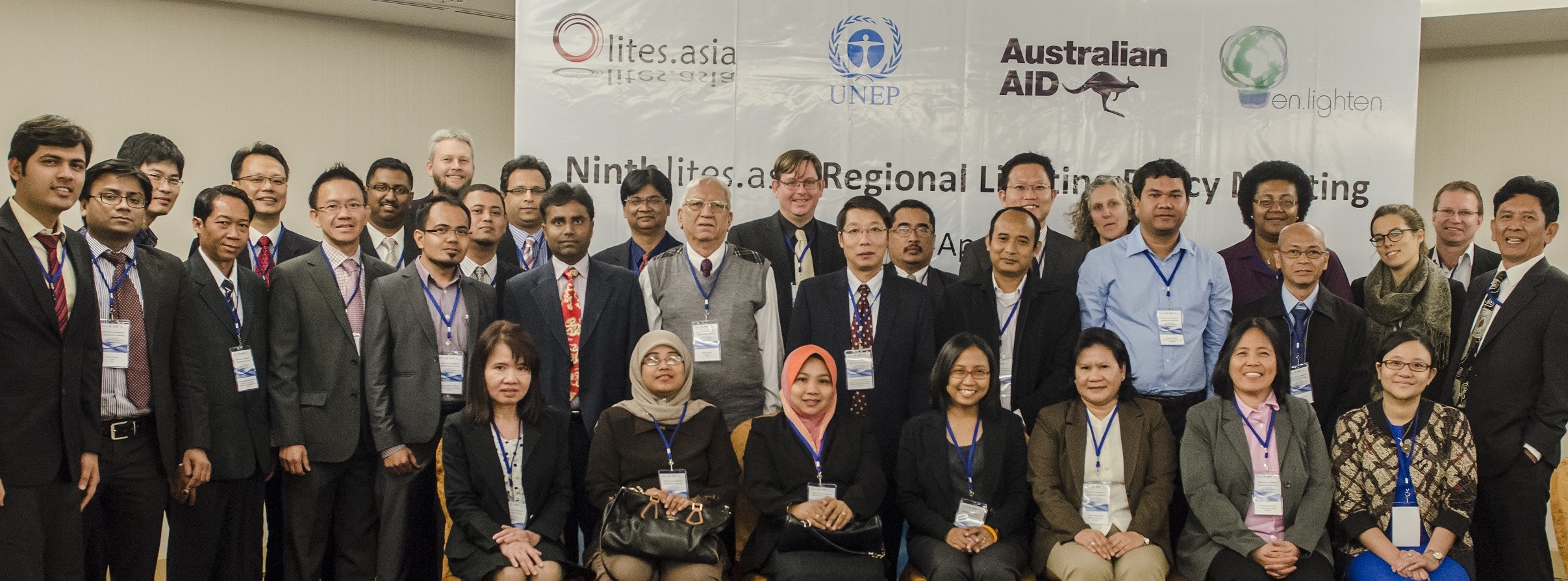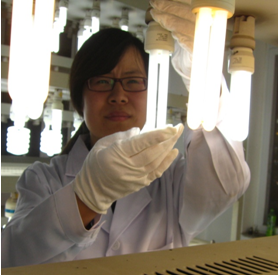In this issue we provide:
- A summary of the April 2014 lites.asia meeting in Kuala Lumpur;
- An update on UNEP en.lighten’s Southeast Asia and Pacific Monitoring, Verification and Enforcement Project;
- An overview of the final results of the lites.asia collaborative labelling display survey project;
- A reminder of the vote for the IEC TC 34 Technical Specification for CFLs.
Kuala Lumpur lites.asia meeting
The ninth lites.asia regional policy workshop was held in Kuala Lumpur, Malaysia on 22-23 April 2014. Attendees included 37 representatives from 16 countries. The meeting focussed on efficient lighting monitoring, verification and enforcement (MVE) activities and infrastructure in Southeast Asia and the Pacific. It also included updates on lighting standards developments and a briefing on off-grid lighting testing and laboratory certification.

This was the first lites.asia meeting under the auspices of the United Nations Environment Programme (UNEP) en.lighten initiative as part of their Southeast Asia and Pacific MVE Project, which is funded by the Government of Australia.
The first day of the meeting updated delegates on international standards development and complementary program activities and on individual countries’ experience with standards, labelling and compliance.
On the second day, the focus was on MVE best practices and the support available to countries through the Southeast Asia and Pacific MVE Project. In particular, it sought to investigate with delegates the areas where they felt most support was needed and in what format it would be best received.
Many issues were raised during the discussion sessions, including:
- Institutional management capacity building and training;
- Legislation development;
- Registration systems;
- Test laboratory capacity building;
- Establishing benchmarks (e.g. en.lighten lamp testing and market baseline assessment);
- Mutual recognition agreements for laboratories and sharing of testing information.
For more information, the programme, meeting report and presentations can be downloaded from the lites.asia website at www.lites.asia/downloads/kuala-lumpur-2014.
UNEP support for monitoring, verification and enforcement activities in Southeast Asia and the Pacific
The recent transfer of responsibility for the lites.asia Secretariat to the United Nations Environment Programme (UNEP) en.lighten initiative brings with it new opportunities for support for monitoring, verification and enforcement (MVE) activities in the Southeast Asian and Pacific regions.
The Southeast Asia and Pacific MVE Project, supported by the Government of Australia until June 2015, will increase UNEP en.lighten initiative outreach to support countries’ rapid transition to energy-efficient lighting. It provides provision for practical support and the development of new resources to address the needs and market situations in target countries to help them implement and maintain successful MVE regimes. This support covers five main areas:
|
Capacity building for testing laboratories
Technical tools
|
 |
 |
Policy support
|
Assistance with developing funding proposals
-
Support to explore national and regional funding opportunities;
-
Assistance to draft proposals;
-
Allocation of resources and assistance to support the development of efficient lighting Nationally Appropriate Mitigation Actions (NAMAs).
Collaborative labelling display survey final results
The lites.asia labelling display survey project was developed at the request of lites.asia members and was a joint initiative between lites.asia and agencies in seven participating countries – Australia, India, Pakistan, Philippines, Sri Lanka, Thailand and Vietnam. lites.asia developed the methodology and guidelines for the project and provided analysis of the results; while the countries undertook national surveys of a sample of lighting retail outlets to check whether lighting products were being labelled correctly. The majority of lamps sampled where CFLs (91% of 22,405 lighting products).
The methodology called for two surveys – an initial survey, followed by appropriate actions to follow up suppliers and/or retailers found to be non-compliant; and a repeat survey to assess the impact of these actions on compliance rates.
The overall objectives of the project were four-fold:
To gain experience in undertaking labelling surveys
Through participation in the project, all participants have gained experience in undertaking labelling display surveys. This experience will be valuable for further monitoring activities, both at the national and international level.
To improve the level of national understanding of labelling compliance
At the national level, all the surveys demonstrated the levels of uptake of labels for lighting products and rates of compliance and helped to pinpoint where, and what type of, issues exist and to identify potential solutions. The results of the analysis of the individual country surveys can be found in the project report.
To identify the key areas of similarity or variation in labelling non-compliance in the region
- The large variety in scope of the surveys, and the variations amongst the type of programs participating, make it difficult to make meaningful direct comparisons of compliance rates. However, some key results show that:
- Non-labelling of eligible lighting products is by far the largest cause of non-compliance;
- No instances of the use of fake labels were reported;
- There are a large number of suppliers or brands in the market, each supplying small quantities of products that creates unique challenges.
To measure the improvement in compliance rates through increased market surveillance and communication with suppliers
During the project period, only Australia was able to complete two surveys, with inconclusive results. Although the compliance rates in the worst performing stores in the first survey increased from 21%-35%, the sample was small and highly influenced by change in stocks in one store. Further experience from other repeat surveys is therefore necessary before robust conclusions can be drawn.
In conclusion, it is clear that the surveys have each provided much useful information that would not have been available otherwise and that the results are of major benefit to national programs. Furthermore, the joint project has revealed communication issues for lighting and may indicate that a different monitoring, verification and enforcement approach is required for lighting than for other technologies.
The final report on the project is available to download on the lites.asia website at www.lites.asia/downloads/labelling-display-survey.
Important vote for IEC technical specification on CFL performance levels draws closer
Over a number of years, the potential value to lites.asia member countries of an IEC technical specification which specifies a number of performance levels that can be applied to self-ballasted CFLs intended for general lighting services has been a discussion topic at lites.asia meetings.
The IEC proposal ‘PNW 34A-1754: Self-ballasted compact fluorescent lamps for general lighting services - Performance limits’ for such a technical specification is now open for voting, with the close of vote on 23 May 2014.
Members of lites.asia from countries that are voting members of IEC TC 34 are encouraged to contact their National Committee to discuss their countries' voting plans.
More information on the technical specification and the voting process can be found on the lites.asia website at www.lites.asia/news-and-events/news/iec-cfl-performance-tiers.
Dates for your Diary
IEC proposal 34A/1754/NP PNW 34A-1754: Self-ballasted compact fluorescent lamps for general lighting services - Performance limits
23 May 2014
IEC TC34 Project Team and Panel meetings and workshops
23-27 June 2014 and 30 June- 4 July 2014 – Berlin, Germany
18-21 September 2014 – New Delhi, India
